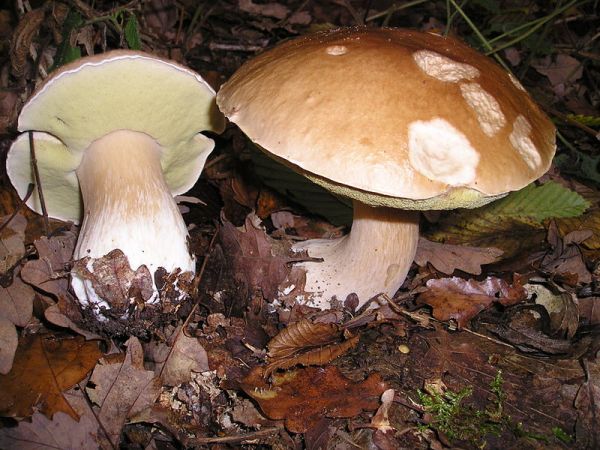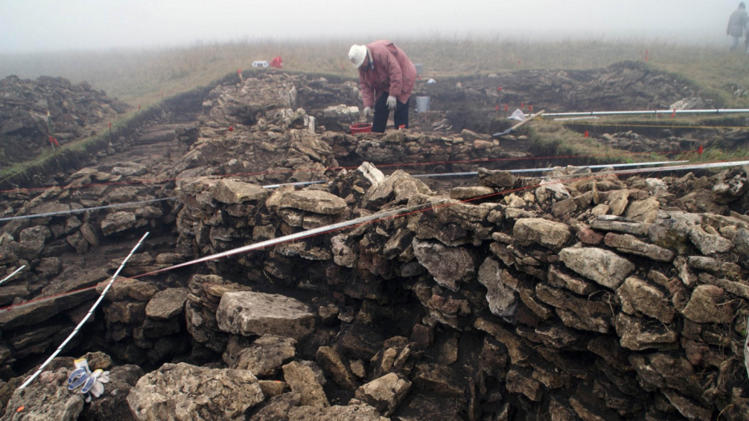
This
study investigates the effect of Sildenafil (a synthetic drug that is
known to much of the public as “Viagra”) on the growth and shape of the
mushroom
Boletus edulis (a Basidiomycete of the
Boletaceae family), diffused in the beechwood trees (
Fagus) of Ticino, the region with Italian culture located in the Southern part of Switzerland.
Background: About Sildenafil, and these Mushrooms, and Fractal Analysis
The
pharmacological compound Sildenafil has been shown to treat the male
erectile dysfunction “impotentia erigendi” by inhibiting a set of
c-Phospodiesterase-5 enzymes, what in turn intensifies the blood afflux
into the “corpora cavernosa”, filling them up to turgidity leading to
penis erection. (Dunzendorfer 2004).
Mushrooms of
Boletaceae family including the
Boletus edulis
type, mostly display a phallus-like morphology formed by a stalk and a
cap (pileus) whose extent and consistency may be influenced by various
environmental agents, including growth factors and complex molecules
such as polyphenols and other natural antioxidants.
Some
analogies were noticed between Sildenafil and the chemical structure of
natural polyphenols, flavonoids and many other cyclic compounds as
rosmarinic acid abundant in macro-fungi, which exhibited an antioxidant
free-radical scavenging activity (Guo et al. 2012). These morphological
and physiological properties prompted us to investigate the role of
Sildenafil on the proliferative capacity and on the morphological
changes of
Boletus type growing in the natural habitat of a
Fagus forest.
Proper
morphologic measures were obtained by means of an analytical approach
based on the principles of fractal geometry developed by Mandelbrot
(1982). These principles can be used to unravel irregular pattern of
biological elements and complex physio-pathological phenomena that could
not reliably be understood by means of conventional Euclidean geometry
(which is more appropriate for describing ideal regular objects).
The term fractal (fractus i.e. fragmented) derives from the Latin verb
frangere and
means to break, to create irregular fragments. To be called fractals,
biological and/ or natural objects must fulfill a certain number of
theoretic and methodological criteria including a high level of
organization, shape irregularity, functional/morphological and temporal
auto-similarity, scale invariance, iterative pathways and a non-integer
peculiar fractal dimension [FD]. Whereas mathematical objects are
invariant or self- similar over an unlimited range of scales, actual
biological components and living structures are statistically
self-similar entities iterated within a fractal domain called a “scaling
window” (Losa 2012). Only within this scaling window can the object’s
fractal dimension be calculated. The fractal dimension is a numerical
statistical measure that one can use to describe these kinds of
irregular shapes and self-similar processes and, on all scales large and
small, to correlate their shapes with the functional behaviors. This is
a powerful tool for better understanding a good many kinds of
biological tissues, both normal and pathological.
Fractal Geometry Principles
In
nature, a fractal object is defined by its structural properties,
namely by surface rugosity and/or absence of smoothness, form invariance
or self-similarity, complexity and a fractal dimension [FD] usually
greater than the topological dimension [DT]. The Richardson-Mandelbrot
equation provides the mathematical basis for understanding geometric and
spatial fractal structures, namely L(ε)=N(ε). (ε) (1) where L(ε)
represents the length of the biological component under investigation,
(ε) the unit length of measure and N(ε) the number of unit lengths (ε)
needed to cover the contour L(ε). By a logarithmic substitution the
above equation can be rewritten as: log[L(ε)/lo] = (1-D) log[ε/lo] (2)
This equation depicts a straight line with slope 1-D, from which the
dimensional exponent D can be calculated to yield the numerical value of
the fractal dimension [FD] (Losa & Nonnenmacher 1996).
Material and Methods
Two square domains, each with a surface area of 100 m2
(10 m x 10 m side), were selected inside of a beech (Fagus) forest
along the line Insubrica crossing the central zone of Ticino in southern
Switzerland. Both domains located at convenient distance in order to
avoid spatial overlapping or any other undesirable effect.
To the
test domain we applied 50 mg of Sildenafil per square meter of surface
area. This corresponds to a dose usually prescribed to human males and
gauged with respect to the estimated median human body surface of 2 m2 (Haycock 1978).
The control area received a placebo deprived of the active substance.
Active
compound and placebo were dispersed through the forest domains
distinctly delimited by a visible red ribbon. In both area of interest,
measurements were performed in the afternoon at a fixed time (5 pm),
just preceding the planned treatment which was repeated every two days
during fourteen days. Experiments were conducted during the first two
weeks of September, a time of year that is usually characterized by
stable meteorological conditions with an external day temperature
interval between 18-30ºC. This period also featured an absence of moon —
we chose this time so as to prevent malicious sarcastic popular
comments evoked when scientific knowledge is missing.
All Boletus grown in untreated (control) and treated areas were counted and the numerical density [#B/m2]
established. Specimens from both area were selected according to a
random systematic procedure usually applied in stereology, sagittal
sections cut through the entire fungus and pictures taken at 10 X
magnification projected onto a two-dimensional plane. Well-identifiable
cap and stalk profile outlines were segmented from grey level-threshold
images by means of Image J program and from these digital micro-graphs
the fractal parameters determined by using the FANAL++ package. This
analysis included subroutines for applying the box-counting method,
implementation of the power law equation, data fitting, visualization of
the true fractal domain called “scaling window”, and delimitation by
upper and lower limits [ε1,ε2] of a bi-asymptotic
curve fitting in a double logarithmic plot from which a straight line
can be drawn, its slope being used to evaluate the fractal dimension
[FD]. Both scaling limits were defined by determining the widest
interval [log ε1-log ε2] within the standard
deviation of the estimated slope. The practical evaluation of the
fractal dimension could be obtained by the box counting method based on
counting of the non-empty boxes N at a variable grid length (ε)
(Dollinger et al. 1998).
Results
Data from
Boletus
specimens collected in the domain exposed to Sildenafil showed a
significant growth increase as expressed by the numerical density [#B/m
2],
which ranged from 0.15 at time zero to 0.5 at day 14 of treatment,
whilst it remained stable around 0.2 without significant changes in the
control domain. A significant reduction of the fractal dimension FD from
1.22 to 1.11 was measured, what actually quantified the loss of
irregularity or complexity occurring on both stalk and cap border
outlines during the treatment period. These results contrasted with
those recorded on
Boletus samples found in the control domain,
where both parameters i.e. the fractal dimension [FD] of stalk and cap
border outlines and the numerical density [#B/m
2] remained rather constant along the investigation period, with a median value accounting for 0.15 and 1.22 for [#B/m
2] and FD respectively (Figure 1).
Discussion
While
the morphological, physiological and biochemical effects of Sildenafil
on human male sexual apparatus are well documented, its action on
Boletus edulis mushroom became clear only as a result of this study. We found two quantifiable, notable effects of the drug on the mushrooms:
(A)
a reduction of the fractal dimension [FD] which documented an increased
smoothness of cap and stalk borders; and (B) the increment of the
numerical density.
Likely, the reduction of border
irregularity is provoked by the stretching of cap surface and
simultaneously, on the other, under side, by increased consistency or
firmness of stalk tissue during growth. As far as is known, most
biological processes governing growth and shape of fungi are not well
understood — science still struggles to make complete sense of the
complexity and specificity of their biological pattern. [For example,
due to lack of chlorophyll, the fungus is unable to manufacture
carbohydrates such as sugar, the backbone for the chemicals needed for
life must be retrieved from the tissues of other organisms. Acids, iron,
calcium, and other inorganic materials are derived from the soil, wood,
or animal substances in which the mycelia grow, while not much fat was
found nor starches were formed (Figure 2).] Compelling evidence has led
to certainty that drawing of water and basic food material occurs by the
mycelium from the place where it grows.
Knowing
the role of sildenafil on certain parts of the male human body, one can
easily hypothesize an analogous effect on other, rather different
biological targets such as
Boletus mushrooms. According to such
a hypothesis, in these mushrooms, a strengthened lymph drawing and
water afflux suitable to permeate the roughage tissue, thus favoring
both firmness of stalk and smoothness of cap. If so, then the effect
induced in mushrooms might mimic the polymorphous effect observed in
human males.
But how to explain the observed diverging behavior? On the one hand, the numerical density [#B/m
2] increased by 35%, proving a significant growth of
Boletus
after fourteen days of treatment. On the other hand, the height
dimensions of specimens treated with Sildenafil were found smaller than
those of control area, with data interval ranging between 6.5-8.1 cm and
7.4-9.6 cm respectively.
Hence in this experimental system the growth rate was inversely related to
Boletus height. The fractal dimension values recorded on the cap and stalk border outlines of
Boletus
mushrooms deserved a critical comparison with data recovered in the
living realm; in the former fractal dimension values ranged between 1.10
and 1.23 rather close to fractal dimension values recorded on contour
profiles of most biological structures and cell tissues, notably liver
cells, healthy lymphoid and white blood cells, leukemic circulating
cells, oocytes, immature astrocytes and neuronal cells, all
characterized by a similar degree of irregularity (Losa &
Nonnenmacher 1996).
Unfortunately, fractal dimension data on
mushrooms have never been calculated (or at least have not been reported
in the scientific literature).
To sum up: The numerical density (#B/m
2) of the mushroom was increasing with time, i.e. from 0.15/m
2 up to 0.5/ m
2
at day 14 of treatment, while the fractal density reduced from 1.23 to
1.11. Thus, there was a significant reduction of border profile
complexity and irregularity in
Boletus mushrooms that were treated with Sildenifil, a drug that provokes penile erections in human males.
Conclusion
To put this in simple terms:
Our
investigation highlighted the main fractal principle which rests on the
unlimited iteration of a unit fragment as a chief generator, either
determined or unknown, until completion of the whole structure. The same
principle serves to explain the fractality of growth mechanisms, the
irregularity of morphological structures and the complex dynamics of
living processes which occur at different spatial and temporal scales in
connection with the principle of the recursive genome function
(Pellionisz 2008), all the phenomena implicated in growth and
maintenance of the fascinating and mysterious kingdom of mushrooms.




























